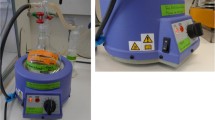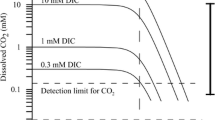Abstract
A procedure which includes the Total Reduced Inorganic Sulfur (TRIS) in a single distillation step is described for the radiotracer measurement of sulfate reduction in sediments. The TRIS includes both Acid Volatile Sulfide (AVS: H2S + FeS) and the remaining Chromium Reducible Sulfur (CRS: S0, FeS2). The single-step distillation was simpler and faster than the consecutive distillations of AVS and CRS. It also resulted in higher (4–50%) sulfate reduction rates than those obtained from the sum of35S in AVS and CRS. The difference was largest when the sediment had been dried after AVS but before CRS distillation. Relative to the35S-AVS distillation alone, the35S-TRIS single-step distallation yielded 8–87% higher reduction rates. The separation and recovery of FeS, S0 and FeS2 was studied under three distillation conditions: 1) cold acid, 2) cold acid with Cr2+, and 3) hot acid with Cr2+. The FeS was recovered by cold acid alone while pyrite was recovered by cold acid with Cr2+. A smaller S0 fraction, presumably of the finer crystal sizes, was recovered also in the cold acid with Cr2+ while most of the S0 required hot acid with Cr2+ for reduction to H2S.
Similar content being viewed by others
References
Albert DB (1985) Sulfate reduction and iron sulfide formation in sediments of the Pamlico River estuary, North Carolina. Ph.D. thesis, The University of North Carolina, Chapel Hill, NC
American Public Health Association (1971) Standard methods for the examination of water and wastewater. 13th ed.
Berner RA (1964) Distribution and diagenesis of sulfur in some sediments from the Gulf of California. Marine Geology 1: 117–140
Berner RA (1969) The synthesis of framboidal pyrite. Economic Geology 64: 383–384
Berner RA (1970) Sedimentary pyrite formation. American Journal of Science 268: 1–23
Berner RA (1974) Iron sulfides in Pleistocene deep Black Sea sediments and their paleo-oceanographic significance. In: Degens ET & Ross DA (Eds) The Black Sea — Geology, Chemistry, and Biology (pp 524–531) The American Association of Petroleum Geologists, Tulsa
Boulegue J, Lord III CJ & Church TM (1982) Sulfur speciation and associated trace metals (Fe, Cu) in the pore waters of Great Marsh, Delaware, Geochimica et Cosmochimica Acta 46: 453–464
Brock TD & O'Dea K (1977) Amorphous ferrous sulfide as a reducing agent for culture of anaerobes. Applied and Environmental Microbiology 33: 254–265
Canfield DE, Raiswell R, Westrich JT, Reaves CM & Berner RA (1986) The use of chromium reduction in the analysis of reduced inorganic sulfur in sediments and shales. Chemical Geology 54: 149–155
Chanton JP & Martens CS (1985) The effects of heat and stannous chloride addition on the active distillation of acid volatile sulfide from pyrite-rich marine sediment samples. Biogeochemistry 1: 375–383
Cline JD (1969) Spectrophotometric determination of hydrogen sulfide in natural waters. Limnology and Oceanography 14: 454–458
Cutter GA & Oatts TJ (1987) Determination of dissolved sulfide and sedimentary sulfur speciation using gas chromatography-photoionization detection. Analytical Chemistry 59: 717–721
Howarth RW (1979) Pyrite: Its rapid formation in a salt marsh and its importance in the ecosystem metabolism. Science 203: 49–51
Howarth RW & Giblin A (1983) Sulfate reduction in the salt marshes at Sapelo Island, Georgia. Limnology and Oceanography 28: 70–82
Howarth RW & Jørgensen BB (1984) Formation of35S-labelled elemental sulfur and pyrite in coastal marine sediments (Limfjorden and Kysing Fjord, Denmark) during short term35SO4 2−-reduction measurements. Geochimica et Cosmochimica Acta 48: 1807–1818
Howarth RW & Merkel S (1984) Pyrite formation and the measurement of sulfate reduction in salt marsh sediments. Limnology and Oceanography 29: 598–608
Howarth RW & Teal JM (1979) Sulfate reduction in a New England salt marsh. Limnology and Oceanography 24: 999–1013
Howarth RW, Giblin A, Gale J Peterson BJ & Luther III GW (1983) Reduced sulfur components in the porewaters of a New England salt marsh. In: Hallberg R (Ed) Environmental Biochemistry. Ecological Bulletin (Stockholm) 35: 135–152
Howes BL, Dacey JW and King GM (1984) Carbon flow through oxygen and sulfate reduction pathways in salt marsh sediments. Limnology and Oceanography 29: 1037–1051
Ivanov MV (1968) Microbiological processes in the formation of sulfur deposits. Israel Program for Scientific Translationa, Jerusalem
Jørgensen BB (1977) The sulfur cycle of a coastal marine sediment (Limfjorden, Denmark). Limnology and Ocanography 22: 814–822
Jørgensen BB (1978) A comparison of methods for the quantification of bacterial sulfate reduction in coastal marine sediments. I. Measurement with radiotracer techniques. Geomicrobiology Journal 1: 11–27
Jørgensen BB & Fenchel T (1974) The sulfur cycle of a marine model system. Marine Biology 24: 189–201
King GM (1983) Sulfate reduction in Georgia salt marsh soils: An evaluation of pyrite formation by use of35S and55Fe tracers. Limnology and Oceanography 28: 987–995
King GM, Howes BL & Dacey JWH (1985) Short-term products of sulfate reduction in a salt marsh: formation of acid volatile sulfides, elemental sulfur, and pyrite. Geochimica et Cosmochimica Acta 49: 1561–1566
Lein AY, Vaynshteyn MB, Namsarayev BB, Kashparova YE, Matrosov AG, Bondar VA & Ivanov MV (1982) Biogeochemistry of anaerobic diagenesis of recent Baltic sediments. Geochemistry International 19 /2: 90–103
Luther III GW (1987) Pyrite oxidation and reduction — Molecular-orbital theory considerations. Geochimica et Cosmochimica Acta 51: 3193–3199
Luther III GW, Giblin AE & Varsolona R (1985) Polarographic analysis of sulfur species in marine porewaters. Limnology and Oceanography 30: 727–736
Peters DG, Hayes JM & Hieftje GM (1974) Chemical separations and measurements. Theory and practice of analytical chemistry. WB Saunders Comp., Philadelphia
Rosser HR & Hamilton WA (1983) Simple assay for accurate determination of (35S) sulfate reduction activity. Applied and Environmental Microbiology 45: 1956–1959
Skyring GW (1987) Sulfate reduction in coastal ecosystems. Geomicrobiology Journal 5: 295–374
Sorokin YI (1962) Experimental investigations of bacterial sulfate reduction in the Black Sea using S-35. Microbiology 31: 329–335 (Eng. transl.)
Sweeney RE & Kaplan IR (1973) Pyrite framboid formation: Laboratory synthesis and marine sediments. Economic Geology 68: 618–634
Thode-Andersen S & Jørgensen BB (1989) Sulfate reduction and formation of35S-labelled FeS, FeS2, and S10 in coastal marine sediments. Limnology and Oceanography (in press)
Troelsen H & Jørgensen BB (1982) Seasonal dynamics of elemental sulfur in two coastal sediments. Estuarine, Coastal and Shelf Science 15: 255–266
Voge HH (1939) Exchange reactions with radiosulfur. Journal of the American Chemical Society 61: 1032–1035
Westrich JT (1983) The consequences and controls of bacterial sulfate reduction in marine sediments. Ph.D. thesis, Yale Univ., New Haven, Conn
Zhabina NN & Volkov II (1978) A method of determination of various sulfur compounds in sea sediments and rocks. In: Krumbein WE (Ed) Environmental Biogeochemistry and Geomicrobiology. Vol. 3 (pp 735–746) Ann Arbor Science Publishers, Michigan
Author information
Authors and Affiliations
Rights and permissions
About this article
Cite this article
Fossing, H., Jørgensen, B.B. Measurement of bacterial sulfate reduction in sediments: Evaluation of a single-step chromium reduction method. Biogeochemistry 8, 205–222 (1989). https://doi.org/10.1007/BF00002889
Issue Date:
DOI: https://doi.org/10.1007/BF00002889




